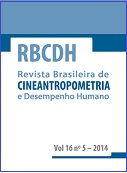Four weeks of blood flow restricted training increases time to exhaustion at severe intensity cycling exercise
DOI:
https://doi.org/10.1590/1980-0037.2014v16n5p570Abstract
The present study aimed to verify the effects of 4 weeks of low-intensity blood flow restricted (BFR) training on time to exhaustion (Tlim) at severe-intensity exercise. Thirteen physically active subjects (23 ± 3.4 years; 70.6 ± 7.8 kg; 170.9 ± 10 cm) were assigned to one of two groups: low-intensity interval training with (BFR, n=9) or without (CON, n=4) blood flow restricted. The interval training sessions consisted of 2 sets of 5-8 × 2-min intervals at 30% of peak power output (Ppeak) obtained during incremental exercise for LOW and BFR, separated by 1min of rest. For BFR a cuff was inflated (140-200mmHg) during the exercise bouts and deflated during rest intervals. The pressure was increased 20mmHg after three completed sessions, thus, in the last week the pressure applied was 200mmHg. Before and after 4 weeks intervention period, all subjects completed an incremental exercise until exhaustion and one-step transition to a severe-intensity work rate (110%Ppeak). The results revealed that BFR (Pre: 227 ± 44s vs. Post: 338 ± 76s), but not CON (Pre: 236 ± 24s vs. Post: 212 ± 26s), increase significantly Tlim at 110%Ppeak. It can be concluded that 4 weeks of BFR training, but not CON, increased the exercise tolerance at severe intensity domain. Therefore, the increased metabolic and physiologic strains induced by BFR, not the exercise intensity per se (30%Ppeak), seem to have been responsible to trigger the adaptive responses linked to longer Tlim after BFR training.



